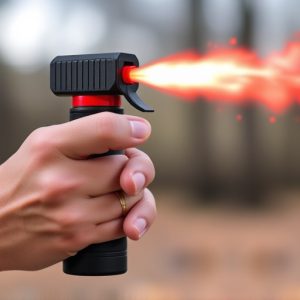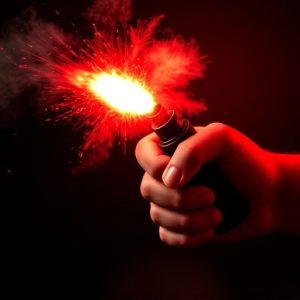Exploring Peaceful Defense: Alternatives to Guns for Safety and Conflict Resolution
Non-lethal alternatives to guns for self-defense and conflict resolution have been developed to pri…….
Non-lethal alternatives to guns for self-defense and conflict resolution have been developed to prioritize safety and minimize harm. Pepper spray temporarily incapacitates assailants without causing lasting injury, while stun guns and Tasers subdue attackers with electric shocks, reducing the risk of fatalities. Personal alarms sound loud warnings to deter threats. Martial arts offer physical defense skills and mental discipline, promoting peaceful resolution and non-lethal engagement. These ancient practices complement modern devices like acoustic and kinetic impact projectiles, as well as advanced technologies such as UAVs and autonomous robots in high-risk situations. The embrace of these alternatives is part of a global shift towards more responsible use of force, emphasizing safety, human dignity, and the reduction of potential harm in various conflict scenarios.
In recent years, the dialogue around personal safety and conflict resolution has evolved, prompting a reevaluation of traditional approaches reliant on firearms. This article delves into the multifaceted world of alternative weapons to guns, offering insights into non-lethal defense mechanisms that prioritize safety and de-escalation. We explore the efficacy of traditional martial arts as viable means for self-defense, examining how ancient techniques can be just as potent in today’s landscape. Additionally, we highlight cutting-edge technologies and devices that serve as modern substitutes for firearms, tailored to various scenarios where security is paramount. Join us as we navigate this critical conversation on alternative weapons to guns and their roles in personal defense and conflict resolution.
Exploring Non-Lethal Alternatives to Guns for Self-Defense and Conflict Resolution
The search for effective alternative weapons to guns for self-defense and conflict resolution has led to a variety of options that prioritize safety, minimizing harm, and non-lethal outcomes. Pepper spray, for instance, is a widely recognized tool that can incapacitate an assailant with a powerful irritant, temporarily impairing their vision and respiratory functions without causing permanent injury. Stun guns or Tasers deliver a high-voltage electric shock, which is effective in subduing attackers while reducing the risk of fatal confrontations. These devices are designed to give individuals a means to protect themselves without resorting to lethal force. Similarly, personal alarms can be a deterrent, emitting a loud sound that attracts attention and deters potential threats. Training in martial arts or self-defense techniques is another non-lethal alternative, empowering individuals with the skills to de-escalate situations or defend themselves if necessary. The choice of an alternative weapon should be informed by legal considerations, personal capabilities, and specific circumstances, ensuring that the response to a threat is appropriate and proportionate. It’s clear that exploring non-lethal alternatives to guns for self-defense not only enhances personal safety but also contributes to broader societal safety by potentially reducing the incidence of serious injury or fatality resulting from confrontations.
The Role of Traditional Martial Arts in Offering Effective Defense Without Firearms
Martial arts have been practiced for centuries as a means of self-defense, offering a range of alternative weapons to guns that rely on the practitioner’s skill and physical prowess. Traditional martial arts such as Karate, Judo, and Aikido teach the effective use of an individual’s own body as a weapon, emphasizing techniques like strikes, throws, and joint locks. These disciplines not only enhance physical fitness but also instill mental fortitude, discipline, and situational awareness—skills that are invaluable in self-defense scenarios where firearms are absent. The principles of martial arts focus on avoiding confrontation when possible, diffusing tension, and neutralizing threats with minimal force necessary. By mastering these traditional practices, individuals can confidently rely on alternative weapons to guns, understanding the importance of leveraging their surroundings and personal abilities to maintain safety without resorting to firearms.
Furthermore, the study and practice of martial arts encompass a holistic approach to self-defense. It is not solely about learning techniques but also about cultivating an inner strength and peace. The training involved in martial arts disciplines like Kung Fu or Taekwondo can help individuals stay composed under pressure, which is critical when faced with a potentially threatening situation. The effectiveness of these traditional methods lies in their adaptability to various environments and the ability to respond to attacks using the human body as an alternative weapon to guns. This approach not only serves as a practical defense mechanism but also promotes a deeper understanding of the importance of non-violent conflict resolution, making it a valuable skill set for anyone seeking to enhance their personal safety without relying on firearms.
Innovative Technologies and Devices as Modern Substitutes for Firearms in Various Scenarios
In the realm of self-defense and conflict resolution, the search for alternatives to firearms has led to the development and adoption of various innovative technologies and devices. These modern substitutes are designed to offer effective protection while minimizing potential harm. For instance, pepper spray and stun guns provide non-lethal options for personal safety, capable of incapacitating an assailant without causing permanent injury or loss of life. In law enforcement and crowd management scenarios, electroshock weapons, such as Tasers, are employed to subdue individuals in a controlled manner. These devices deliver a high-voltage electric shock that can be calibrated to the level of threat, ensuring a proportionate response. Additionally, advancements in smart material technology have led to the creation of ballistic shields and protective garments capable of withstanding gunfire, offering protection to officers and civilians alike. Such innovations underscore a commitment to finding practical alternatives to firearms that prioritize safety and human dignity across diverse scenarios.
Moreover, the use of non-lethal weapons extends beyond personal defense into military applications. Acoustic devices, for example, can disorient adversaries with targeted sound waves, while kinetic impact projectiles offer a means of crowd control that reduces the risk of lethal outcomes. Furthermore, advancements in robotics and artificial intelligence have led to the deployment of unmanned aerial vehicles (UAVs) and autonomous robots in high-risk situations, capable of performing reconnaissance or even engaging with targets without endangering human lives. These technologies not only serve as effective alternatives to guns but also represent a significant shift towards more responsible and judicious use of force in various settings.


